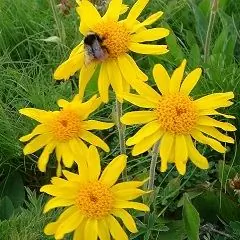Galega
Instructions for use:
- 1. Description of the medicinal
- 2. The chemical composition of the medicinal
- 3. The use of medicinal
- 4.medicinal - honey plant
- 5. Contraindications to medicinal

Galega is a perennial herb belonging to the legume family.
Description of medicinal galega
The plant, from 40 cm to 2.5 m high, has a taproot. Stems are erect, numerous, branched. The leaves are petiolate, pinnate, with stipules, with 5-10 pairs of linear-lanceolate leaves, and at the top are pointed.
Flowers are most often light blue, numerous, with long pedicels, collected in dense axillary racemes. Corolla is light blue or pale violet, butterflies. The calyx is bell-shaped. The plant produces polyspermous fruits, upright pods 2 to 4 cm long. Seeds are smooth, kidney-shaped, greenish-yellow in color.
The plant grows in Ukraine (Crimea, Dneprovsky region, Carpathians), in the Caucasus, in Moldova and in the European part of Russia (Prichernomorsky, Nizhnevolzhsky regions).
It grows on the banks and valleys of rivers, along roads, among bushes, in steppes and mountainous areas, on forest edges, in beech, in subtropical humid forests.
For medicinal purposes, the seeds and herbs of the plant (flowers, leaves, stems) are used.
The chemical composition of galega officinalis
The plant contains alkaloids, saponins and other nitrogen-containing compounds: 4-hydroxygalegin, galegin.
The roots of the galega contain triterpenoids.
Alkaloids, carbohydrates, peganin, vazicinone and other nitrogen-containing compounds were found in the herb of the plant: tannins, kaempferol, pipekolinic acid, ascorbic acid, rutin, flavonoids, quercetin, carotene, bitter substances, galegin, tannin, phenolcarboxylic acids and their derivatives into (p-coumarin, coffee, ferulic, synapic).
The seeds of the plant contain sucrose, steroids, stachyose, alkaloids, saponins and other nitrogen-containing compounds, fatty oil, as well as acids: stearic, linolenic, linoleic, palmitic.
The use of galega medicinal

The effect of galegin in scientific medicine has been studied. When injected into a vein, it causes an increase in blood pressure. When applied topically, it constricts the pupils. Galegin constricts blood vessels, inhibits intestinal motility and enhances the secretion of breast milk.
Galegin is used in the treatment of diabetes as an adjunct to insulin treatment, which allows its dosage to be reduced. Galega seed infusions are used for the same purposes.
The galegin in the herb has a hypoglycemic effect, while peganin is able to tone up smooth muscles.
Galega preparations have a diuretic and diaphoretic effect. In women in labor, milk secretion is increased.
In folk medicine, decoctions and infusions from galega medicinal are used for diabetes mellitus, and also as an anthelmintic agent.
Medicinal galega - honey plant
Galega has long been recognized as the best honey plant. This plant is capable of producing as much nectar as sainfoin. The plant blooms with the white acacia in mid-May. Flowering continues throughout the month. Bees collect about 200 kg of nectar from one hectare. It is much easier for bees to pollinate this plant, since there is no tripling in it, which allows the bees to not pinch the proboscis in the process of collecting nectar.
After the end of flowering, the grass must be mowed, then the plant will bloom in August and will bloom until mid-September.
Contraindications for medicinal galega
Galega preparations should be used with caution. Long-term use of them causes high blood pressure and can interfere with bowel function.
Doctors do not recommend pregnant women to use galega preparations. Hypotension and hypertension are also contraindications for use.
Information about the drug is generalized, provided for informational purposes only and does not replace the official instructions. Self-medication is hazardous to health!







